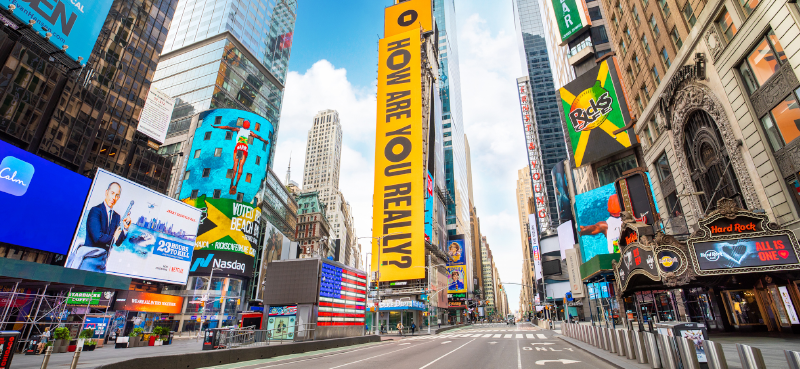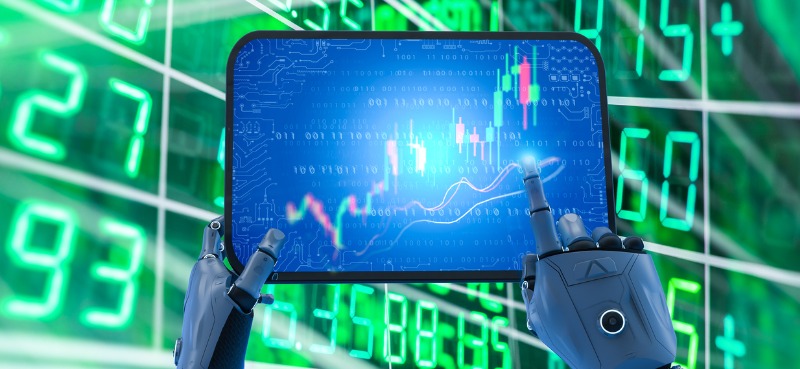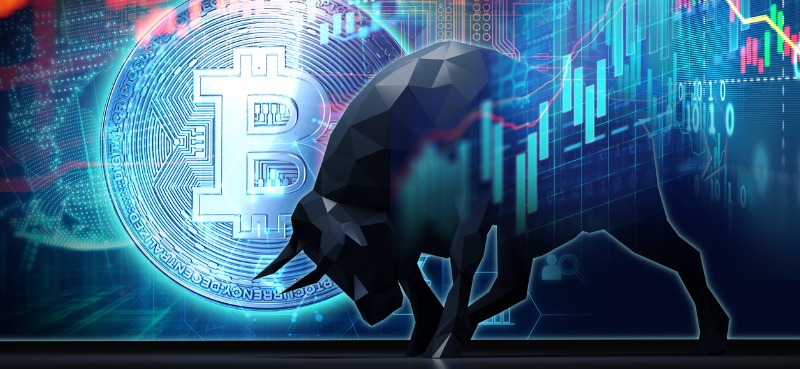Markets are in rally mode, having risen a few percentage points in just days. But before you get too bullish, listen to what’s behind it…
On today’s show, I share why the strong start to earnings season is misleading… why the market isn’t as cheap as it looks… and why next year’s earnings estimates need to come way down.
My bearish thesis hasn’t changed—and this mini rally gives us the perfect opportunity to bet against the market. Last week, I hosted an briefing to prepare you for a impending market crash. And I shared an amazing strategy for multiplying your money as stocks fall.
Watch the replay here.
- What’s really behind this rally [0:30]
- Earnings aren’t as good as they look [8:35]
- Why stocks can’t keep rising [19:20]
- The current market P/E is misleading [22:55]
- How to make a fortune once stocks start crashing again [34:30]
Wall Street Unplugged | 735
How to succeed in a rigged market
Announcer: Wall Street Unplugged looks beyond the regular headlines heard on mainstream financial media to bring you unscripted interviews and breaking commentary direct from Wall Street right to you on main street.
Frank Curzio: What’s going on out there? It’s October 18th. I’m Frank Curzio, host of the Wall Street Unplugged podcast, where I break down the headlines and tell you what’s really moving these markets. Wow, what a rally. The markets are up about 6% in a few days… As earnings, at least the early stage, are coming ahead of estimates, especially for banks. Banks are pretty much always the first to report about Co. used to be that; there’s just so many stocks, but it’s mostly banks that report first. So, you got about 30, 40% of the S&P 500 reporting so far, or actually just 30 or 40 companies. It’s very early in the season. So, you have a lot more companies to report, especially later this week, into next week, the next two weeks, we’ll get a real glimpse at earnings.
Frank Curzio: The dollar is falling. Bond yields are easing with 10 years now under 4%. And that’s really the key to this rally. I mean, if you look at the dollar, it’s about the dollar, about rates. That’s what’s really driving the equity markets, the markets as a whole. And we’ve seen the dollar continue to surge as we’re the best of all the garbage fiat currencies. Everybody floods here when things are bad every place else. And it’s been surging. But that’s definitely the key to the rally.
Frank Curzio: And now, you’ve seen the bulls out in full force, which you can’t blame them. I mean, most of these guys have been buying or at least telling us to buy stocks, which I hope that means that they’re buying as well, almost on a daily basis for months, as the market’s been crashing.
Frank Curzio: And it’s kind of funny when you think about it, how bulls hate bears and bears hate bulls. That’s just the way it is, growing up. So, I was fortunate, where my dad was kind of a permabear and Cramer was a permabull. So, to get both of those and learn under those two people, and great people, it was amazing for me. It helped my career tremendously. I wasn’t biased to anything. I saw both sides. I learned about growth investing and value, and value’s been so out of favor such a long time, that we’re, you know, value, what are you talking about? I don’t want value. Growth, growth, growth. That’s what it’s all about, that’s what we saw.
Frank Curzio: But it’s funny because when one jumps to the other side, it’s like they’re celebrity. I mean, it’s the same with politics. We’re liberals, conservatives, we’re no longer allowed to like each other, hate each other. When Bill Maher, who is a liberal, calls out the far left, who wants to defund the police, rip down statues, have teachers condition your first grader, how changing their gender is okay, Fox News suddenly loves Bill Maher. He’s all over TV. So, when you flip-flop, it’s kind of cool because everyone’s like, “Oh, we love this guy now.” But get to the point which is, Mike Wilson, Chief Financial Officer at Morgan Stanley. This is one of the few investment banks. Who runs the investment bank? Chief Financial Officer. I don’t want to say runs the CEO, but influences a decision when it comes to the investment side, he was calling for a major pullback for a while now.
Frank Curzio: Okay, the only investment bank which is by far lowest estimates on the street. Not saying that others weren’t predicting, but he was saying the mark’s going to fall a lot further. And he’s been right, he’s definitely been right so far. And again, low on the street. When we say the numbers are low on the street, that means they’re the lowest from the estimate. So they have the high, the street estimate, it means the highest of all the analysts, when they figure out that earnings number or whatever, or even economists, the highest on the street is based on those estimates from institutions. And he was the lowest when it came to the market and the S&P, and how far it would fall. But now he’s saying that, “Hey, you know what? We could see a 10% rally from here based on sentiment indicators, based on what we’ve seen in the past.”
Frank Curzio: Maybe earnings come in a little bit better than expected, and everybody loves this guy, he’s great. All the bulls are like, “Yeah, did you listen to Mike Wilson, Mike Wilson.” And you heard it, well, I don’t believe that. That’s not going to happen. And you heard that months ago, and he’s been right. And now they’re like, “Oh no, now you got to listen to him” which we find funny. But the bulls are kind of celebrating Mike’s bullish call even though, if you look closely at what he said, he said, “This is a bear market rally.”
Frank Curzio: And we’ve seen these sentiment indicators, they’re extremely pushed to one side where we should have rallied for a little while, I guess. And we’ve seen a couple of rallies here, and they always fall off, but they get to the point where everyone’s leaning to one side, it’s so bad. So, all you need is a little bump up and what do you have? You have everyone trying to cover their shorts.
Frank Curzio: Also, an interesting post on Twitter a couple days ago, this person posted data on previous market crashes dating back to 1872. I think it was 26 of them. The person, I forgot his name, but it was a good post, it was a good post. I think he’s a good analyst. But he said at a drawdown of 28% for the S&P 500 (this was before this rally), the stock market is now pricing to 85% of a typical bear market, which in a typical bear market, you see a 33% decline, and a 78% of a recession, where, during recessions, the S&P 500 declines around 35% on average. So, he said we’re 20% of the way there, meaning that there’s very little downside if you’re looking at past markets.
Frank Curzio: So, I love data because it’s factual, it’s data; yet, you could interpret it any way you want. And that’s what separates the good analyst from the bad analyst, where economists look at data that’s factual, it’s their opinion on what’s going to happen, which is nonsense, right? That’s what we see. So, they’re reporting stuff, “The last time we saw this was this year, and then when this happened, this happened.” It’s easy to say, “Okay, this always happened in the past, and this is why it’s going to happen this time around.” But you have to interpret it, you have to look at it in a certain way because everything this guy posted, and it was a great chart, it was awesome. But looking at it makes you think you should be buying stocks like crazy. Go all in. Again, simply based on that screen. And my question, and I actually retweeted this with a quote. I asked him on Twitter because the whole spreadsheet, I mean, it includes these crashed average market pullback, average PE, before and after the market crash.
Frank Curzio: I mean, it was actually a cool screen, but I asked him, I said in these past, and I quoted typical bear markets because these are the typical bear markets, he took the average of them. It includes 26 on dating back to 1872. So, in these past typical bear markets, can you list the ones where the Fed was playing to aggressively raise rates for another three to six months and reduce its balance sheet by trillions when the market was already down 20% plus? I said don’t bother looking; there’s no comparables. And this is where I think we’ve run into problems here because we look at data and we say, “Wow, you should be playing.” And these typical bear markets, every bear market is different. This one, we’ve never seen anything like this. I’m just talking the bear market, but we’ve never seen the amount of money flooding into the market due to COVID, 0% interest rates this long. It’s crazy.
Frank Curzio: You’re watching this and saying, “Wow, the markets are up, and we’re doing okay now,” and they’re pulling back a little bit. I’m doing this in the middle of the day here, and they went up sharply yesterday. They were up a lot more than what they are now, and I don’t know where they’re going to finish. Maybe they finish much higher, maybe they finish much lower, but they pulled off of their highs to 10 years, now back over 4% as I’m doing this. When we started this, it was lower than 4%. And much lower; I think it was 3.8. So, a little bit of a reversal going on here, but for those of you who think this rally is sustainable, or even normal, where stocks rise by 6% in two days, it’s not. Not when the Fed’s expected to aggressively raise rates over the next two months.
Frank Curzio: And let’s break this down. So the past two days, the major indices rising substantially, again, just two days. Substantially. But it’s not being led by a sector, it’s not being led by certain, “Hey, Microsoft put out great earnings so it’s going to bring up the whole sector within cloud, or software, or whatever. It’s not that. It’s two days in a row where we have had 10 to one days that that would seem, 10 to one advance over decliners. This is extremely, extremely rare to see a market like this where everything is going higher, not just specific sectors. It’s extremely rare where this type of event never happens during normal conditions. It happens when we have a lot of confusion, a lot of shit going on, big sell-offs and it rebounds really quick.
Frank Curzio: That’s typical, very common in the middle of a bear market. If we look at last quarter earnings season, exactly where we are in earning season today, just when the banks report, a few companies are starting to report. What happened? So three months ago, look at mid-July. We’re expecting earnings to roll over, and they didn’t. Most companies, I believe it was 68% of them, beat estimates.
Frank Curzio: That’s around average when you look at the last five years and 10 years, just to let you know. That 68, 70% usually beat those earnings estimates. But let’s talk about these estimates because yes, again, that data is a fact and you’d be like, “Wow, they’re beating estimates, that’s awesome.” These estimates were revised lower into the quarter, the last quarter, into that earning season. So, it wasn’t hard for these companies to beat those revised estimates. And it was like, “Oh, even though the Feds are raising rates, the economy’s doing fine. These companies, how they’re pricing, they’re doing great.” And the S&P rallied 10% into August, and then fell sharply from 4,300 to 3,600, which was a 16% drop. So, we saw a 10% rally in August, and then a steep drop of 16%. I remember those companies that rallied alongside with everyone else include Nike, FedEx, CarMax, Levi’s.
Frank Curzio: Again, these names rallied sharply only to crash at their significantly lowered estimates. And they reported, what? Two weeks ago, three weeks ago, they were late reporters. This is where FedEx, again, is another company that rallied in that 10% rally, who turned around and reported earnings, pretty much a month later, and removed its guidance completely. Now, we’re heading into this quarter, same thing. Banks are being celebrated because they beat estimates. Said earlier, these are the companies that are first to report. If you look at these estimates, they’re showing profit of their clients on average a 15% plus from last year. That’s massive. So yeah, they’re beating, but they’ve been low, and they’ve been reduced significantly, those estimates, heading into this quarter.
Frank Curzio: I know this is data that we get. You don’t see this. Companies, they don’t report on CNBC, don’t report on a lot of the free sites where JP Morgan says, “Hey, we’re lowing estimates. We’re lowing estimates from 505 or 510 to 440 on Disney.” You don’t know that happened. But a lot of companies are doing the same thing where you’re like, “Wow, Disney’s trading,” and you look like three months ago, two months ago, you say, “Disney’s trading at 21 times FOLD earnings, or 20 times FOLD earnings. Well, those FOLD earnings for 2023 now just went from like 515, Morgan Stanley’s not the only one. You’ve seen other companies lower. Now that estimate’s 440.
Frank Curzio: Now this company’s trading a lot, lot higher when it comes to a PE because earnings are a lot lower. And then, when they go into the quarter they will report 445, and everyone’s like “Disney beat, they’re fine.” That’s the game that’s being played right now. But at the end of the day, the earnings are the earnings. And what I mean by that is 440 is not good if you thought they were going to report 525, 2 months ago. So, if they go 440, it’s still 445. That means you’re looking at Disney trading at much, much higher multiples than you originally thought two months ago simply because these analysts are lowering estimates and nobody sees that go. You only hear when they upgrade and downgrade and make major calls. That’s what you hear on CNBC. You don’t see them all lowering these estimates into the quarter.
Frank Curzio: And this is very, very important for you to understand because it makes it easy for these companies to beat their revised estimates. And now, you see the market rally, and it may continue. This is one of the things I was afraid of, what earnings… But hey, you know what? Earnings are holding up a little bit just like they did last time before you see more companies lower in between quarters, and it might hold up into the first week of November, the second week, right, because we have the elections. Republicans are now projected to take the Senate and the House, which was not the case three weeks ago. I mean it was kind of close, and they were saying lean and Democrat. I mean, at least now it’s for the Republicans to take the Senate. But now, the odds are increasing a ton. They’re really shifting right now. And a split government’s always good for stocks, and by that I mean catalyst, right? But let’s talk about what happens after the elections. Now earning seasons over, what’s going to happen?
Frank Curzio: The Fed’s going to continue to aggressively raise rates. They’re not stopping, especially since the core CPI, that’s the core CPI, right? So, you have the regular core, the core CPI strips out food and energy, and then you have unemployment, right? Those are the two gauges that is really CPI. But the number one thing is the core CPI. That is what’s the most important thing to the Fed when they’re looking at an inflationary indicator. Number one, by far. And this indicator, it hasn’t peaked yet. We haven’t seen it peak. We’ve seen regular CPI peak. Core CPI has not peaked in this market, it’s still going higher.
Frank Curzio: So, what are we going to do? The Fed, obviously, a 75 basis point hike in November. I believe that’s November 2nd, and then another 75 basis point hike in December, taking us to an incredible 4.75%. Guys, that’s 1.5% higher than where we are right now. Where the housing market is frozen. I say frozen from a lot. You’re going to see people with cash, yeah, that’s fine, they’ll buy a house. People will have to move, are going to pay… But most of it, if you listen out there, even the people that were doing great, are saying, “Hey, we’re starting to see it now, and we’re preparing.” You’re definitely not seeing that market where money was free, and they’re buying houses like crazy. I mean, that mortgage payment is significantly higher now, significantly. All of you know that if you own a house. Look at the current loan, how much money you’re on your house or the loan. The average loan is $400,000 right now, that’s average with the average home price around 500, it’s down from there.
Frank Curzio: The average home price because home prices have been declining in most areas, 90% of the areas in America. But if you look at those numbers, holy shit, just put it in a calculator, you’ll see the difference between a 3% rate and a 7% rate, or even a 5% rate where you saw a dramatic slowdown. Now it’s seven. Now, you’re looking at today, the Home Builder Survey. 10-year low, this is the Home Builder Survey. This is what they’re saying. These are the people that are saying, “Hey, over the next six, 12 months, what we see in the market, how we are structuring our CapEx. And the NAHB came out and said, “This is unsustainable.” They actually used the word unsustainable, meaning that we’re going to see markets come down much, much more, especially even right now if the Fed stops. But rates are going much higher. Interest rates are scheduled to go much, much higher if the Fed continues, which again, they are.
Frank Curzio: And you look at housing is one of, if not the biggest drivers of GDP. Look around your house, of everything you buy. It’s the reason why appliance makers are warning, a lot of companies are warning, lumber prices are crashing. I mean, that filters into, do you how many jobs? Holy cow.
Frank Curzio: And how many items that you’re buying, that you’re purchasing, that you can put on buy now, pay later. Holy shit. Was that not the sign of the top of the market? Everyone’s jumping in to buy now, pay later. God, that doesn’t get worse than that. I think that’s the ultimate top right there, with so many companies’ coming out there a year ago, two years ago. Holy cow, it’s crazy. And then, let’s talk about the rest of the whirl. We’re saddled with the highest debt levels in the country’s history. And I remember when it used to be, “Hey, if you hit a hundred percent debt to GDP,” these guys are well, well past that. Something like 200% plus, well, well past that. So, what do higher rates do? It means much, much higher debt payments on their debt. But it’s already crushing old, developed countries and tons of emerging markets. And rates are going even higher.
Frank Curzio: This is why you see a central bank like the Bank of England, major, major central bank, raise rates on September 22nd and then start buying bonds three weeks later, which is easing because pension funds are getting margin calls. And I’m hearing reports like, “Oh, everything’s okay right now. We’re good, we’re good. We’ve figured it out, we figured it out.” You figured it out in three weeks? You freaking figured it out? Really? Because rates are about to surge from here. I don’t know what you figured out, or what you did, or how you hedge that? I have no freaking idea, but everybody believes, “Oh, everything’s okay now.” It’s not like, “Hey this happened, long-term credit or the credit crisis in 2008, where everyone was, “Fuck” and everyone’s like, “Holy shit, this market’s coming down, down, down, down, down, and we need to do something.” And then you bail out the system.
Frank Curzio: There’s no bailouts here. There’s just rates that continue to go higher and higher and higher. And they have their own problems in Europe when it comes to energy, which we all know due to Russia… Especially Germany, it’s supplying 40% of their energy needs. Good luck with that. And you’re trying to place sanctions on Russia, you’re trying to mess with them? Crazy when you think about it. But that’s what happens, and that’s what’s happening now. And I think that’s a big point that people don’t understand. Even if the Fed stops, you think everything’s going to be okay. This is happening now, and the Fed’s going to go 1.75% higher by the end of this year or 1.5% higher by the end of this year. Maybe they do a 50 basis point hike. Big deal. You’re still going to continue to raise, probably through March. And if you think this rally could be sustained, they’re probably going to go even higher, well past 5%, thinking, “Hey, the economy’s fine. Look at the markets, let’s keep going.”
Frank Curzio: But what happens with these other countries? As things get worse, and they’re going to get a lot worse, they start flooding into the dollar. They’re going to drive it higher, at least into mid next year. As we see, the higher dollar is bad for equities. Retail has to be the S&P 500 companies to generate 40% of their sales overseas. You want proof, look at Nike, look at the data. They say they’re going to lose $900 million in EBIT, that’s earnings before interest and taxes, that’s a pure number. It’s EBIT, EBITDA, and then you can report earnings, and you can manipulate that, that last number so much. This EBIT, that’s $900 million next year simply due to currency. And I said, wait a minute, how much are they going to report in earnings before interest and taxes? How much are they going to report? And when you look at it, that’s close to 20% just on currency, not demand.
Frank Curzio: That has nothing to do with inventory levels, which they report the highest inventory levels, I want to say, on a dollar basis easily by far in a company’s history. Was it $9 billion or something like that? 44% inventories were up. We’re talking about currency here. You could say, “Well, that currency could lead to less demand because if the dollar’s going higher, it means other countries are doing bad, which is reduced… I get it, but you see what currency does, and we’re not talking about the war, we’re not talking about Fed. We’re just talking about currency issues as the dollar goes higher and higher. How can it go higher from here? Every other country, as rates go higher, you’re just going to be like, “Hey, we’re good man, we’re fine. Our debt doesn’t exist, we’re good.” They can’t print money anymore.
Frank Curzio: But as long as the Fed is aggressively raising rates and shrinking its balance sheet by trillions, and not even close to lowering rates because you still haven’t seen the core CPI hit a top yet, it’s going to be impossible for stocks to go up long-term in this type of environment since the man’s going to continue to fall off a cliff. It’s already fallen off a cliff in housing, autos, semis, which are found in every tech gadget and product. There’s certain sectors that are going to have pricing power. You have Pepsi, you’re going to have Coca-Cola, you going to have some of the consumer staples.
Frank Curzio: Healthcare companies, when you’re getting a check from the government all the time, they can raise prices as much as they want. That’s what happens with tuition as well, when you basically allowing kids to take out $200,000 loans to become first grade teachers. This way they’re paying that off when they’re 68 years old. Nobody tells them, right? They don’t care. The system doesn’t care. Politicians don’t care. Give them $10,000 to reduce their debt by 5%. Good job. Oh my god, now you’re going to buy their vote. Hopefully. No coincidence you’re doing all this stuff just ahead of the election.
Frank Curzio: But getting back to earnings here. Right now, earnings are expected to go up 7% in 2023, from this year. I’m not kidding you, they’re going to go up 7%. Earnings are expected to increase 2% in 2022, in this environment. But if you look at that number, which I told you includes energy, whose profits are expected to pop. I believe it’s over a hundred percent year-over-year. If you strip out energy, and I’m not stripping out like I’m stripping outstripping out staples, tech. I mean, I think there’s a 11 sectors within the S&P 500 and energy still, at this level, is not a big component. It used to be a huge component when Exxon was one of the top companies. Now, you saw the market caps of these are still pretty high, but they’re not two and a half trillion, 3 trillion where Apple, Microsoft got to.
Frank Curzio: So, energy is a very small part, it’s still a relatively small part of the whole S&P 500. But if you exclude energy, S&P 500 profits are down 4%, or expected to be down 4% in 2022, but yet, it’s reporting that it’s up 2%. And now, you’re reporting that on average earnings go up 8% on average annually, right? Seven, 8% on average annually. They’ve gone up over 20% last year, and then in 2018 when Trump lowered corporate taxes, it went about 26, 27%, but on average. So, you really think that next year is an average year, where rates have never been close to this high, you really think it’s an average year where we’re going to see earnings pop 7%? Are you out of your mind? These estimates have to be revised sharply, sharply, sharply lower.
Frank Curzio: Now, management teams and companies, they’re really smart. They’re going to pad their earnings, especially in the short-term, by cutting employment. Every technology company, right, they’re cutting jobs, cutting divisions, cutting CapEx, marketing budgets, but it’s not going to bring back demand. We’re just falling off of a cliff with rates at 3.25%. What about when rates go to 5%? What about when they stay over four and a half percent for all 2023? What do you think’s going to happen?
Frank Curzio: So, you see these companies earning season, doing a good job thus far, beating estimates which revised sharply lower over the past two months. You let me know how in the hell will these companies continue to grow earnings into next year? I have no idea. And this is what I do. And that’s what’s projected. The S&P 500 companies to generate, all the earnings put together, $240 in earnings for 2023. So, when you say the S&P 500 is trading at 17 times, that’s the number they take. They take all the earnings, combine them, which is 240, and it’s the price divided by that number, and that’s how you get the P for the S&P 500. So, you’re used to seeing the P for the S&P 500. You say, “Let’s trade 70 times, 16 times, 15 times.” Again, it’s just a number, right? Or forward earnings.
Frank Curzio: The average being, what? 17 times over the past five years, 15 times over the past 10 years? That’s what the S&P 500 trades, and right now, based on 240, we’re trading at about 16 times forward earnings. So, we’re on average. Stocks roll by. That’s all you see. But let’s dig into the 240 number. Because in 2019, year-end, just before Covid hit, earnings peaked at 159. At the end of 2018, they were 160. The market surged in 2019, that’s why it went from 20 times forward earnings to 25 times forward earnings. But we peaked at earnings in 2019. What changed? A lot. What changed for earnings this year to be at 226 for 2022? 226. Again, they were at 159, 2019. What changed to make these projections to go to 240? That’s what we’re expecting next year, on growth, 240? $11 trillion flooded into this market.
Frank Curzio: This is fiscal and monetary. Rates brought down to zero. And then, when the market opened up and everything went back to normal, which was pretty much close to the end of 2020, into the first quarter of 2021, all asset prices hit record highs. What did our government do? Spend another two, three trillion dollars. That’s what made earnings go to these levels at 240. So, these earnings include a massive pull forward in demand, post-COVID, due to zero rates, $11 trillion added into the market. And now, what’s the Fed doing? They’re raising rates at its fastest pace since the early 1980s. It’s aggressively shrinking its balance sheet in an effort to remove the $11 trillion from the market. So you should say, well those earnings should go back to 2019 at 159. But even at those levels, rates were below 2%. We’re going to 5%, guys. That’s a massive difference.
Frank Curzio: How could that be sustained? I mean, companies could only cut so much when you have no demand. They’re going to cut, cut, cut, cut and yeah, it might result in earnings doing well, but you’re going to see it on the top line where revenue’s going to shrink. They’re losing pricing power. You’re seeing it. I mean, a clear example of the demand destruction is the relief in the supply chain issues, which has seen tons of relief, and not perfect, but tons of relief in these things. Again, I see all this data. I showed it in my newsletters, Goldman Sachs reports it, but other companies have probably been doing this for 30 years. So, I was easily able to tell you how Ford and some other car companies were actually lying, saying, “Hey, it’s going to ease in like six months, second half of the year.” They said that 18 months ago. It wasn’t easing, they were lying to you. That’s why their stocks are getting absolutely hammered much more than their overall market. So now, you’re seeing demand destruction, and it’s going to get worse.
Frank Curzio: So, I don’t want to sound the alarm here and go crazy, guys, I’m just telling you what I see. It’s the Fed. As long as the Fed continues to raise rates, shrink its balance sheet, remove trillions from the market, rallies like this are going to be hard to be sustained. And you’re going to see massive rallies because everyone, everyone now, you’re going to see the markets coming down now a little bit, definitely off its highs, and maybe it goes up for next… But you’re going to see these short positions start coming back in because it just can’t be sustainable. There’s no way we can get to that 240 earnings number. There’s just no way. And remember that 240 number because that 240 number is going to be at 220 next quarter and everyone’s going to say, “Look, we’re beating estimates. Remember, I’m going to tell you what that number is. I guarantee you it’s going to be well below 220.
Frank Curzio: That’s how much estimates are going to be lowered, going in. So, that means we’re not going to see 7% growth, we’re going to see flat growth. That’s what we’re going to report early, and through 2023 you’re going to see get lower, lower and lower, probably below 200. And then, you’re going to say, “Wow, earnings are going to decline 10, 15%, and that’s when we’ll be closing in the bottom. We’ll see if that happens but for now, be very, very careful. It was nice to see a rally in stocks, and you should be a little long. We’re little long in our newsletters and you have good positions, you’re holding on for a long time.
Frank Curzio: But my thesis on equities falling much further in here over the next six to 12 months, very, very much intact. Nothing’s changed, as long as the Fed’s dead set on aggressively raising rates, which they are. And I know most of you are concerned about your portfolio. You listen to this podcast, more downloads than usual. You’re watching financial media channels like CNBC, Fox Business. There’s one quick thing you should know, especially for those bulls that you watch on TV, who said, “We’ve bottomed,” and the Fed tightening. All those negatives. Everything in the market, it’s already priced in. Most of these so-called experts you watch on TV were children the last time we were in an inflationary environment. They were children, including myself.
Frank Curzio: And more than 70% of these people, if I had to guess, I’m throwing that number out there. I’d say at least 70% have only been a professional money manager, analyst, we know who the legends are, but a lot of these guys have been professional fund manager, analysts for less than 12 years. So, they never in their career operated in an environment that didn’t have super low interest rates, and which were near zero for most of their career, or when the Fed was no longer providing easy money, constantly buying bonds in the open market. They’ve never been in a market like that. They’ve always been in a pure bull market, that every decline will be met with buying. It’s significant because these Fed policies, they created one of the greatest bull markets in a generation. 12 years with what? One or two quick hiccups. Even COVID was a hiccup.
Frank Curzio: We’ve bounced back immediately when it comes to the markets. “Oh, the Fed’s there. I told you stock’s going to come back.” 2008, nine, “I told you stocks were going to come back. You have to buy, you always have to buy.” Well, they came back because the government injected hundreds of billions of dollars into the system in 2008, 2009. If they didn’t, would’ve seen 30% unemployment and a lot of people wouldn’t get money out of their banks. If they didn’t inject $11 trillion, we would’ve saw probably 30% bankruptcies. You had, nobody models for zero revenue or a 90% or 80% revenue decline. Look at Delta, look at the cruise ships, look at a transportation company, look at everything, across the board. Hotels, I mean, you saw declines of 80, 90% when we shut off the economy, and a lot of these guys were leveraged through the roof because we had easy policies.
Frank Curzio: So, a lot of these companies in a regular market with no Fed, go bankrupt, but they didn’t because the Fed was there and said, “Hey, we’re just injecting $11 trillion into this market. Everybody will be fine. Checks directly to people. We’re not even going to the banks this time. Forget about that. Let’s go directly to the people and let them spend it like crazy.” That’s gone. You don’t have that anymore, guys. It’s gone. And the Fed, always there to print, bailout banks, flood the mark with cash, buying bonds. Get it, they’re no longer there. And a lot of people operating in this market, especially if you have 10 years of experience which for a very long time, they’ve never seen this type of condition before. And never studied it.
Frank Curzio: And so, not only is this scary where equities could fall a lot further from here, but even if the Fed pauses, which seems to be the bullish thesis here, we’re still going to be at 4%, at least four and a half percent of the Fed funds’ rate, which was zero 12 months ago. So, if they pause, how could you see equities reaching new highs without the help of the housing market, without the help of IPOs? And I mean, where are IPOs? SPACs are dead. Did you see Intel’s Mobileye IPO? What a great purchase by Intel in 2017, they paid 15 billion for it. Last year, it was valued over $50 billion. Why Intel didn’t do the IPO, I have no idea. Why are they waiting until a global recession to do the IPO I have no idea. But right now, that valuation is 16 billion. That’s what’s going to come out at, 16 billion. You could’ve came out at 50 billion, which most companies if you look, was how they came out in SPACs and IPOs over the last 18 months. Or pre-March, when the market really started getting hit.
But if you look at all IPOs that came out before that, those are the ones, just like Mobileye, they affect these crazy valuations that came out as IPOs. And what are they? They’re the ones that have done 70, 80%.
Frank Curzio: This is the new market. I have people coming to me from crypto that have great ideas, and say, “How much you’re looking to raise?” “Well, we’re looking to raise about 3 million with a $20 million valuation.” “How much revenue are you generating?” “Hardly any.” “Forget it, throw it out. No one’s going to invest in you.” You might go to the retail crowd, maybe do a Reg A filing, maybe they’ll come in because people, they’re not smart enough to look at your financials. But there’s no way. I said, “It’s a different market now. You’re lucky if you get a 5 million valuation with no revenue and that idea better be freaking great.” But do you know how hard it is to raise money? Even with metaverse projects where you saw $170 billion come into this market, and a lot of projects getting funded in Web 3 still. But you know how hard it is to raise money out there? I mean this is what’s going on.
Frank Curzio: So, the Fed stops. It’s not like all of a sudden the economy’s going to get better. Rates are staying where they are if they pause, and they’re going to stay there for a while. And when do you see them easing? I don’t see them easing until 2024 at least, unless we get an ultimate market collapse, like a real crash from 30% from here. Then the Fed might be, “Holy shit, we went too far.” Then, they’ll realize it. I mean, there’s definitely deflationary indicators. I saw a guy on CNBC Today highlight deflationary indicators. If you use the Case-Schiller to calculate the CPI, it would show negative and going down. You’re right, you’re right. That’s what my argument was months ago. But the Fed doesn’t care, that’s not what they’re looking at. So, they’re going to continue to raise rates because the core CPI has not peaked. And unemployment, it’s staying stubbornly low for now. Even though it seems like every company is laying off employees, every large company, especially in technology, hundreds of them. That’s about the Fed.
Frank Curzio: And going back to this rally real quick, what you’re seeing, a 6% gain. And you’re seeing the markets surge, right? At 6% again, they are still coming down a little bit from its highs. This is the number one reason why you should never, especially as an individual investor, ever, ever short the markets. And you could be right and predict a 20% decline over the next 12 months, but the stock market could go up 20% before then. And you look at the NASDAQ was wildly overvalued at the beginning of 1999. Wildly. Everyone was calling that and it started to decline a little bit, then came back, just for 1999. And everyone was like, “Oh my god, the dot com bubble. These things are trading at 25 times forward earnings, crazy at 20 times forward earnings. Most expensive valuation and people were shorting the market. You know what happened? The NASDAQ doubled from 1999 to 2000, before declining by 77% the next three years, two and a half years.
Frank Curzio: So yeah, you’re right. But now, you’re sleeping on a park bench because you’re shorted the market. And simple because you got annihilated in an instant because stocks have popped 10% in a bear market rally before heading sharply lower. And like you see, it could happen very quickly. That’s why I’ve been pitching, buying long dated puts that go out for 12 months. It’s a year. We only going to lose the amount of money you put into a trade, so you don’t care what’s going on right now. You don’t care about the rally. You’re not glued to your TV, calling your broker to buy back every position that you short, and hurry up as fast as you can. And scared shit and losing money. You’re basically betting that the stock or ETF that you’re buying from this put will decline 15% from the price you bought at, over the course of a year.
Frank Curzio: And if it declines further, you’re going to make an absolute killing, which we’ve been shelling. In Moneyflow Trader, which is up 30% on average and annualize each position is up more than a hundred percent because she’s booking these gains within months. This is Genia Turanova.
Frank Curzio: When you see a rally like this, it makes my mouth water because it’s going to provide you with even more opportunities by long dated puts with the pricing, it’s going to be much more in your favor. So, for all of you took me up on an offer for Moneyflow Trader, with one of the best option market specialists, you’re going to find who’s Genia Turanova, you’re actually loving this rally. It’s what you want to see. These big moves hire very quickly, which opens a door for much, much greater returns, if you believe in market individual stocks will fall 15% from here over the next 12 months.
Frank Curzio: An entire free presentation on this, and a lot of you have seen it, some of you are still asking. Just go to curzioresearch.com, it’s for free, for those of you didn’t see it yet. I show all my data on why earnings have to collapse from here. It’s not factored into the markets. It can drive stocks much lower during 2023. And I also provide a special offer for Moneyflow Trader, which retails at $5,000 a year. A lot of people are asking me and said they couldn’t afford it. I said, “Okay, here’s what I’m going to do. Three months at $499, and that’s what our presentation with a special briefing is about. And a lot of people took us up on that, and I’m happy you did. Very, very happy.
Frank Curzio: You don’t have to look at implied volatility, analyze a stock or set to figure out option pricing. Genia does all this for you. All you have to do is open up the alert in your email, go to your online brokerage account and buy the exact put she tells you to buy. Very simple, and we provide a guide for all new investors that simplifies it even more. If you are interested in learning more, go to curzioresearch.com, click the banner or just email frank@curzioresearch.com. We’ve had a lot of people take us up on that. It’s what I’m doing with my money. It’s how you can make an absolute fortune as a market falls, which I think is inevitable. Even though you might be looking at the last two days and going, “Holy shit, it’s going up.” But it’s also going to make you sleep at night while you’re holding some of your favorite positions, which we all are, even in my portfolios, that you plan on holding for longer than three years.
Frank Curzio: It’s the perfect strategy for the market conditions, for these market conditions, because of the extreme volatility at least for another 12 months, probably longer, or until the Fed, not pauses. That’s not the bull. I mean, markets might go up a little bit, then they’re going to go to all time… If we pause here, not at four and a half percent interest rates, they’re not going to go to highs when we were at zero interest rates, it’s not going to happen. Earnings aren’t going to be as strong, there’s no way. But until the Fed actually decides on lower rates, which we may not see until 2024. So, a lot of stuff there to digest, be very careful. Okay, I’m glad for those of you took us up on our offer. I think it’s going to be the best investment you ever made. It’s the lowest I can go. And if you have any questions, comments, I’m here for you, frank@curzioresearch.com, especially with markets like this that are all over the place, have you confused.
Frank Curzio: Lots of news going out. And this is on the front page of every paper, not just financial media, how the market’s going up ,and now they’re coming down, and they’re crashing. And what do you need to do with your portfolio? And holy shit, everything gets amplified because they want you to watch their programs and read them, the headlines and stuff like that. It’s very confusing. And so, you probably listen to this podcast more than ever. Just be careful out there. What you seeing in the past couple days is absolutely common in bear market rallies. Maybe it continues for a little bit longer, but you just have to be careful here. So again, I’m here for you, frank@curzioresearch.com. Really appreciate all support. I’ll see you guys next week. Take care.
Announcer: Wall Street Unplugged is produced by Curzio Research, one of the most respected financial media companies in the industry. The information presented on Wall Street Unplugged is the opinion of its host and guests. You should not base your investment decisions solely on this broadcast. Remember, it’s your money and your responsibility.
























